Principles Of Nursing And Ethics
VerifiedAdded on 2022/07/29
|11
|2943
|25
AI Summary
The assignment is about a case study that is need to be write regarding the question which are given in the form that i have attached .it is an essay
Contribute Materials
Your contribution can guide someone’s learning journey. Share your
documents today.
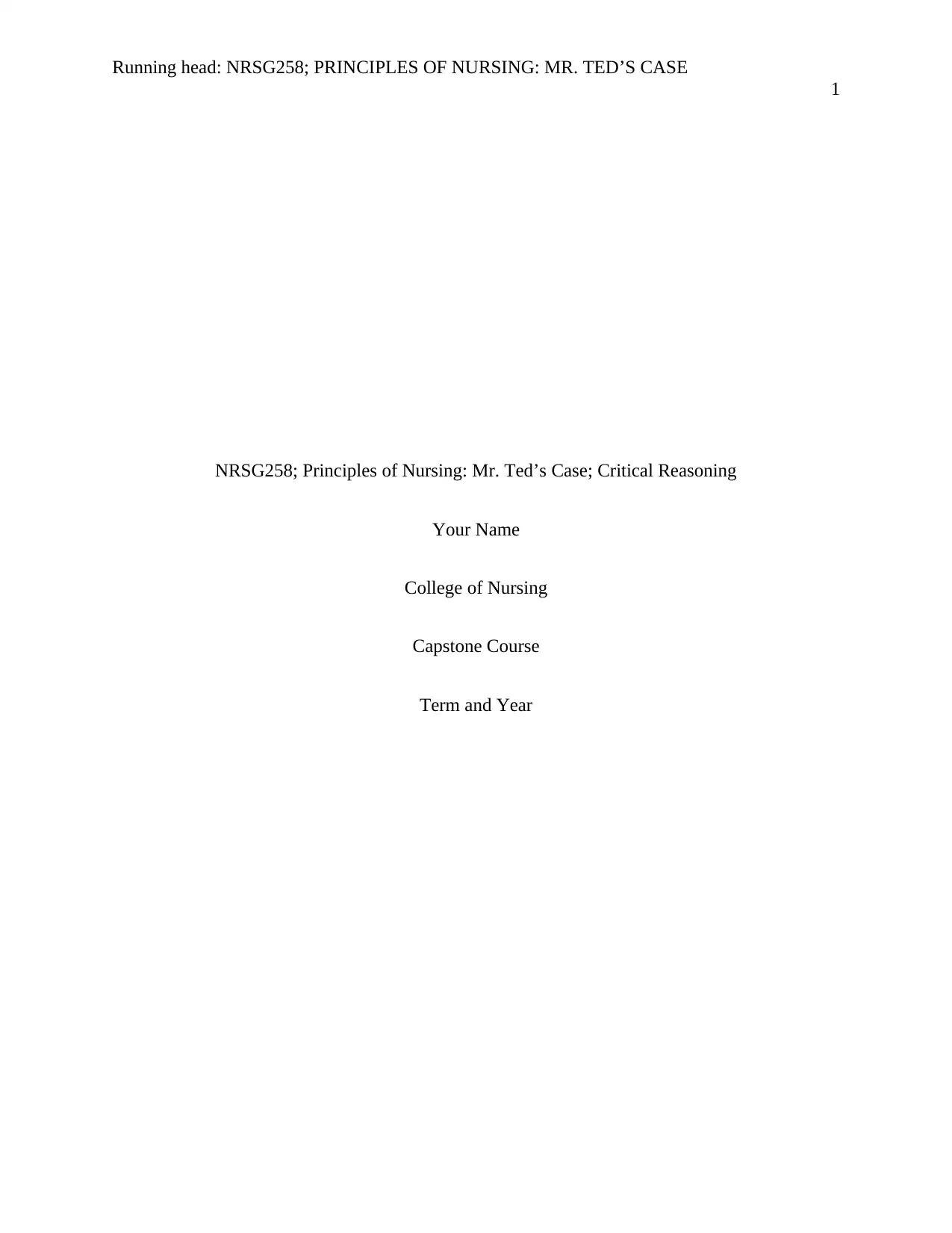
Running head: NRSG258; PRINCIPLES OF NURSING: MR. TED’S CASE
1
NRSG258; Principles of Nursing: Mr. Ted’s Case; Critical Reasoning
Your Name
College of Nursing
Capstone Course
Term and Year
1
NRSG258; Principles of Nursing: Mr. Ted’s Case; Critical Reasoning
Your Name
College of Nursing
Capstone Course
Term and Year
Secure Best Marks with AI Grader
Need help grading? Try our AI Grader for instant feedback on your assignments.
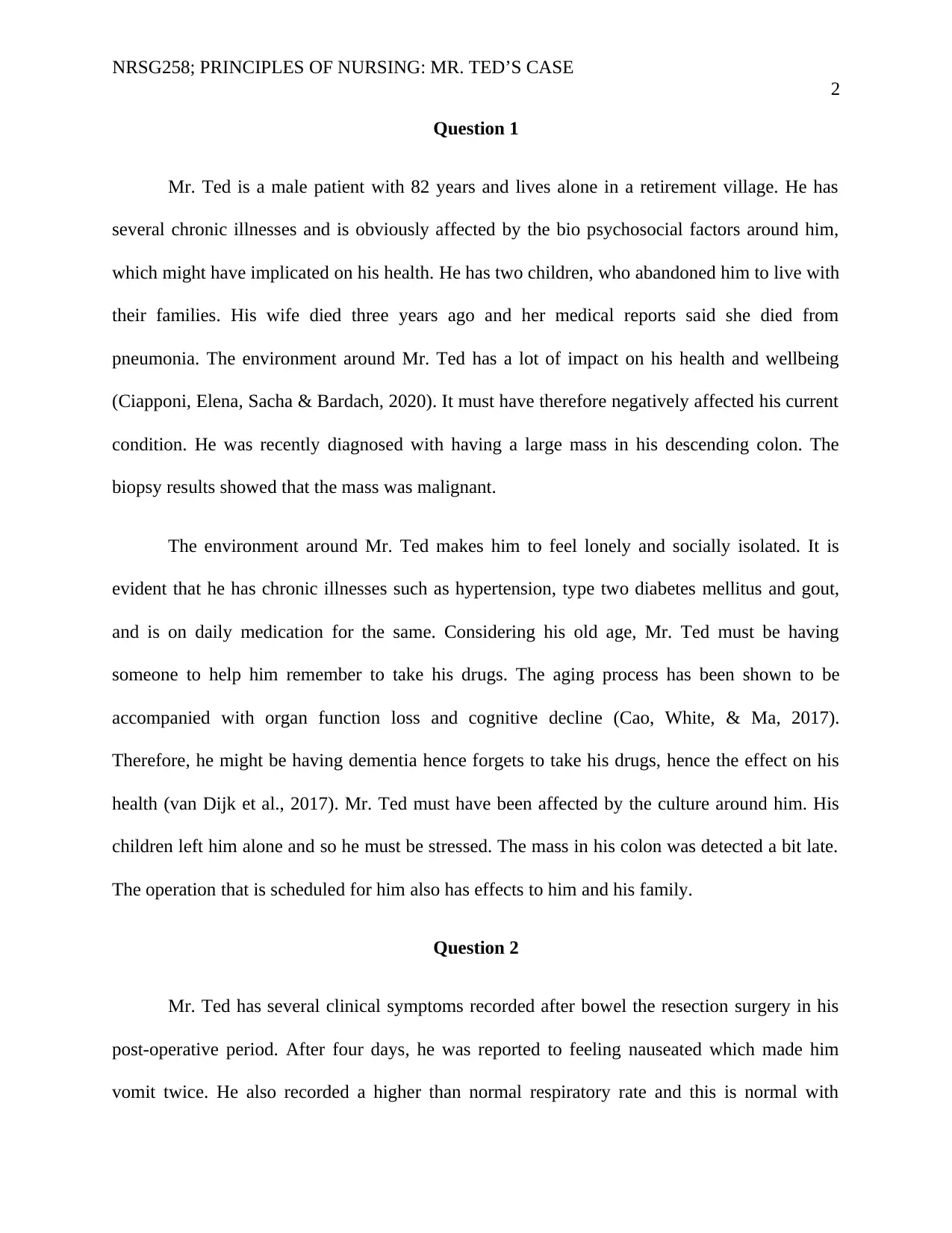
NRSG258; PRINCIPLES OF NURSING: MR. TED’S CASE
2
Question 1
Mr. Ted is a male patient with 82 years and lives alone in a retirement village. He has
several chronic illnesses and is obviously affected by the bio psychosocial factors around him,
which might have implicated on his health. He has two children, who abandoned him to live with
their families. His wife died three years ago and her medical reports said she died from
pneumonia. The environment around Mr. Ted has a lot of impact on his health and wellbeing
(Ciapponi, Elena, Sacha & Bardach, 2020). It must have therefore negatively affected his current
condition. He was recently diagnosed with having a large mass in his descending colon. The
biopsy results showed that the mass was malignant.
The environment around Mr. Ted makes him to feel lonely and socially isolated. It is
evident that he has chronic illnesses such as hypertension, type two diabetes mellitus and gout,
and is on daily medication for the same. Considering his old age, Mr. Ted must be having
someone to help him remember to take his drugs. The aging process has been shown to be
accompanied with organ function loss and cognitive decline (Cao, White, & Ma, 2017).
Therefore, he might be having dementia hence forgets to take his drugs, hence the effect on his
health (van Dijk et al., 2017). Mr. Ted must have been affected by the culture around him. His
children left him alone and so he must be stressed. The mass in his colon was detected a bit late.
The operation that is scheduled for him also has effects to him and his family.
Question 2
Mr. Ted has several clinical symptoms recorded after bowel the resection surgery in his
post-operative period. After four days, he was reported to feeling nauseated which made him
vomit twice. He also recorded a higher than normal respiratory rate and this is normal with
2
Question 1
Mr. Ted is a male patient with 82 years and lives alone in a retirement village. He has
several chronic illnesses and is obviously affected by the bio psychosocial factors around him,
which might have implicated on his health. He has two children, who abandoned him to live with
their families. His wife died three years ago and her medical reports said she died from
pneumonia. The environment around Mr. Ted has a lot of impact on his health and wellbeing
(Ciapponi, Elena, Sacha & Bardach, 2020). It must have therefore negatively affected his current
condition. He was recently diagnosed with having a large mass in his descending colon. The
biopsy results showed that the mass was malignant.
The environment around Mr. Ted makes him to feel lonely and socially isolated. It is
evident that he has chronic illnesses such as hypertension, type two diabetes mellitus and gout,
and is on daily medication for the same. Considering his old age, Mr. Ted must be having
someone to help him remember to take his drugs. The aging process has been shown to be
accompanied with organ function loss and cognitive decline (Cao, White, & Ma, 2017).
Therefore, he might be having dementia hence forgets to take his drugs, hence the effect on his
health (van Dijk et al., 2017). Mr. Ted must have been affected by the culture around him. His
children left him alone and so he must be stressed. The mass in his colon was detected a bit late.
The operation that is scheduled for him also has effects to him and his family.
Question 2
Mr. Ted has several clinical symptoms recorded after bowel the resection surgery in his
post-operative period. After four days, he was reported to feeling nauseated which made him
vomit twice. He also recorded a higher than normal respiratory rate and this is normal with
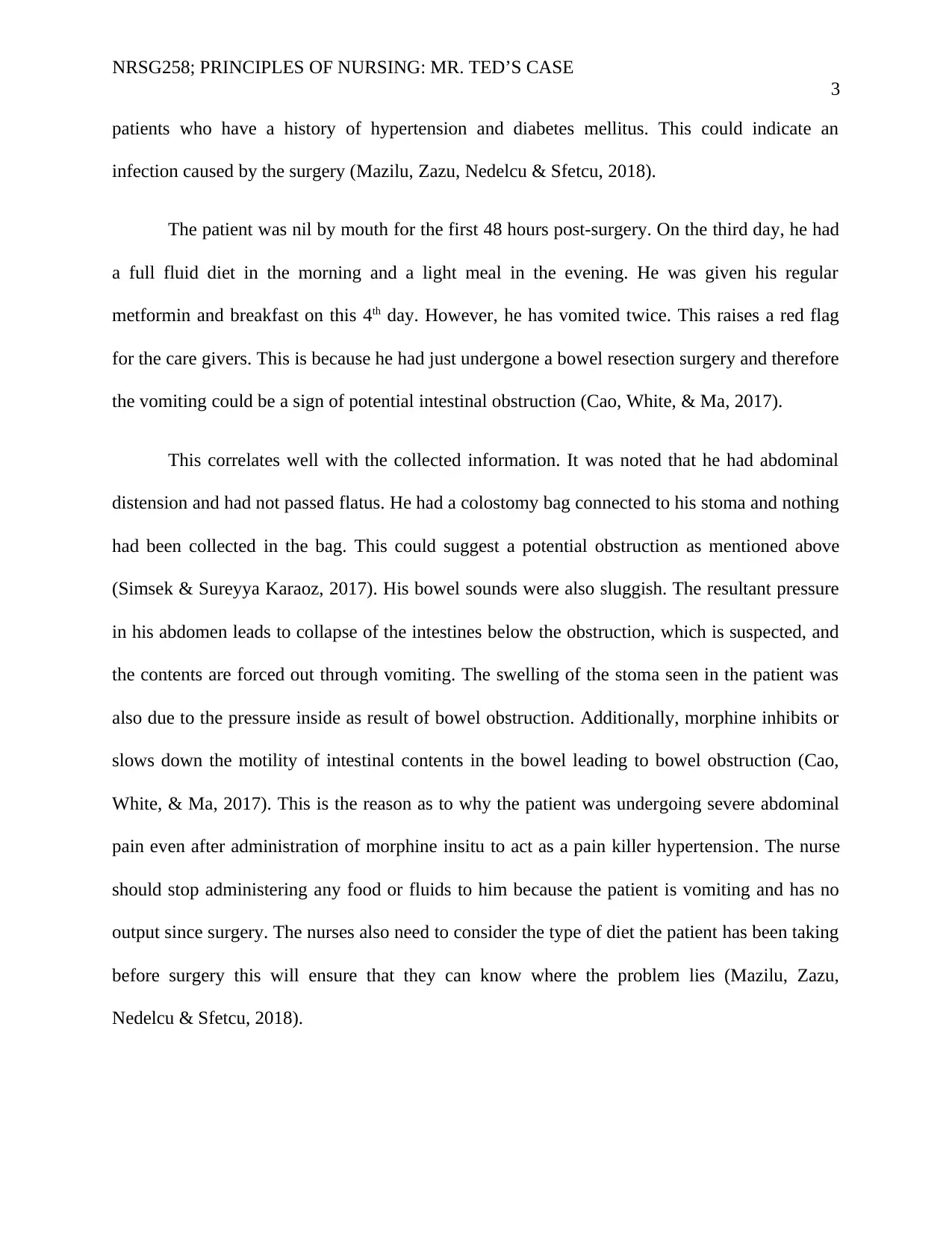
NRSG258; PRINCIPLES OF NURSING: MR. TED’S CASE
3
patients who have a history of hypertension and diabetes mellitus. This could indicate an
infection caused by the surgery (Mazilu, Zazu, Nedelcu & Sfetcu, 2018).
The patient was nil by mouth for the first 48 hours post-surgery. On the third day, he had
a full fluid diet in the morning and a light meal in the evening. He was given his regular
metformin and breakfast on this 4th day. However, he has vomited twice. This raises a red flag
for the care givers. This is because he had just undergone a bowel resection surgery and therefore
the vomiting could be a sign of potential intestinal obstruction (Cao, White, & Ma, 2017).
This correlates well with the collected information. It was noted that he had abdominal
distension and had not passed flatus. He had a colostomy bag connected to his stoma and nothing
had been collected in the bag. This could suggest a potential obstruction as mentioned above
(Simsek & Sureyya Karaoz, 2017). His bowel sounds were also sluggish. The resultant pressure
in his abdomen leads to collapse of the intestines below the obstruction, which is suspected, and
the contents are forced out through vomiting. The swelling of the stoma seen in the patient was
also due to the pressure inside as result of bowel obstruction. Additionally, morphine inhibits or
slows down the motility of intestinal contents in the bowel leading to bowel obstruction (Cao,
White, & Ma, 2017). This is the reason as to why the patient was undergoing severe abdominal
pain even after administration of morphine insitu to act as a pain killer hypertension. The nurse
should stop administering any food or fluids to him because the patient is vomiting and has no
output since surgery. The nurses also need to consider the type of diet the patient has been taking
before surgery this will ensure that they can know where the problem lies (Mazilu, Zazu,
Nedelcu & Sfetcu, 2018).
3
patients who have a history of hypertension and diabetes mellitus. This could indicate an
infection caused by the surgery (Mazilu, Zazu, Nedelcu & Sfetcu, 2018).
The patient was nil by mouth for the first 48 hours post-surgery. On the third day, he had
a full fluid diet in the morning and a light meal in the evening. He was given his regular
metformin and breakfast on this 4th day. However, he has vomited twice. This raises a red flag
for the care givers. This is because he had just undergone a bowel resection surgery and therefore
the vomiting could be a sign of potential intestinal obstruction (Cao, White, & Ma, 2017).
This correlates well with the collected information. It was noted that he had abdominal
distension and had not passed flatus. He had a colostomy bag connected to his stoma and nothing
had been collected in the bag. This could suggest a potential obstruction as mentioned above
(Simsek & Sureyya Karaoz, 2017). His bowel sounds were also sluggish. The resultant pressure
in his abdomen leads to collapse of the intestines below the obstruction, which is suspected, and
the contents are forced out through vomiting. The swelling of the stoma seen in the patient was
also due to the pressure inside as result of bowel obstruction. Additionally, morphine inhibits or
slows down the motility of intestinal contents in the bowel leading to bowel obstruction (Cao,
White, & Ma, 2017). This is the reason as to why the patient was undergoing severe abdominal
pain even after administration of morphine insitu to act as a pain killer hypertension. The nurse
should stop administering any food or fluids to him because the patient is vomiting and has no
output since surgery. The nurses also need to consider the type of diet the patient has been taking
before surgery this will ensure that they can know where the problem lies (Mazilu, Zazu,
Nedelcu & Sfetcu, 2018).
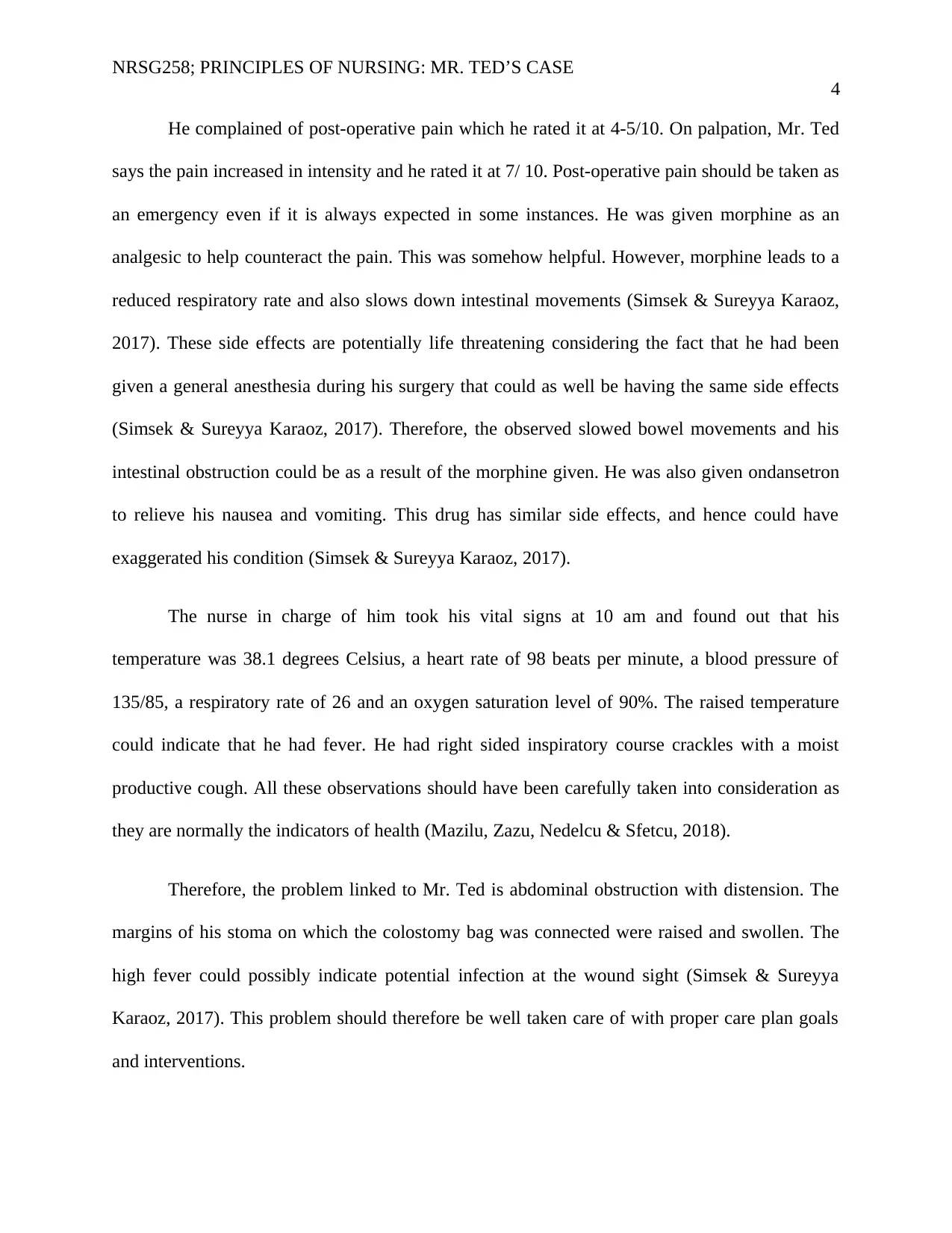
NRSG258; PRINCIPLES OF NURSING: MR. TED’S CASE
4
He complained of post-operative pain which he rated it at 4-5/10. On palpation, Mr. Ted
says the pain increased in intensity and he rated it at 7/ 10. Post-operative pain should be taken as
an emergency even if it is always expected in some instances. He was given morphine as an
analgesic to help counteract the pain. This was somehow helpful. However, morphine leads to a
reduced respiratory rate and also slows down intestinal movements (Simsek & Sureyya Karaoz,
2017). These side effects are potentially life threatening considering the fact that he had been
given a general anesthesia during his surgery that could as well be having the same side effects
(Simsek & Sureyya Karaoz, 2017). Therefore, the observed slowed bowel movements and his
intestinal obstruction could be as a result of the morphine given. He was also given ondansetron
to relieve his nausea and vomiting. This drug has similar side effects, and hence could have
exaggerated his condition (Simsek & Sureyya Karaoz, 2017).
The nurse in charge of him took his vital signs at 10 am and found out that his
temperature was 38.1 degrees Celsius, a heart rate of 98 beats per minute, a blood pressure of
135/85, a respiratory rate of 26 and an oxygen saturation level of 90%. The raised temperature
could indicate that he had fever. He had right sided inspiratory course crackles with a moist
productive cough. All these observations should have been carefully taken into consideration as
they are normally the indicators of health (Mazilu, Zazu, Nedelcu & Sfetcu, 2018).
Therefore, the problem linked to Mr. Ted is abdominal obstruction with distension. The
margins of his stoma on which the colostomy bag was connected were raised and swollen. The
high fever could possibly indicate potential infection at the wound sight (Simsek & Sureyya
Karaoz, 2017). This problem should therefore be well taken care of with proper care plan goals
and interventions.
4
He complained of post-operative pain which he rated it at 4-5/10. On palpation, Mr. Ted
says the pain increased in intensity and he rated it at 7/ 10. Post-operative pain should be taken as
an emergency even if it is always expected in some instances. He was given morphine as an
analgesic to help counteract the pain. This was somehow helpful. However, morphine leads to a
reduced respiratory rate and also slows down intestinal movements (Simsek & Sureyya Karaoz,
2017). These side effects are potentially life threatening considering the fact that he had been
given a general anesthesia during his surgery that could as well be having the same side effects
(Simsek & Sureyya Karaoz, 2017). Therefore, the observed slowed bowel movements and his
intestinal obstruction could be as a result of the morphine given. He was also given ondansetron
to relieve his nausea and vomiting. This drug has similar side effects, and hence could have
exaggerated his condition (Simsek & Sureyya Karaoz, 2017).
The nurse in charge of him took his vital signs at 10 am and found out that his
temperature was 38.1 degrees Celsius, a heart rate of 98 beats per minute, a blood pressure of
135/85, a respiratory rate of 26 and an oxygen saturation level of 90%. The raised temperature
could indicate that he had fever. He had right sided inspiratory course crackles with a moist
productive cough. All these observations should have been carefully taken into consideration as
they are normally the indicators of health (Mazilu, Zazu, Nedelcu & Sfetcu, 2018).
Therefore, the problem linked to Mr. Ted is abdominal obstruction with distension. The
margins of his stoma on which the colostomy bag was connected were raised and swollen. The
high fever could possibly indicate potential infection at the wound sight (Simsek & Sureyya
Karaoz, 2017). This problem should therefore be well taken care of with proper care plan goals
and interventions.
Secure Best Marks with AI Grader
Need help grading? Try our AI Grader for instant feedback on your assignments.
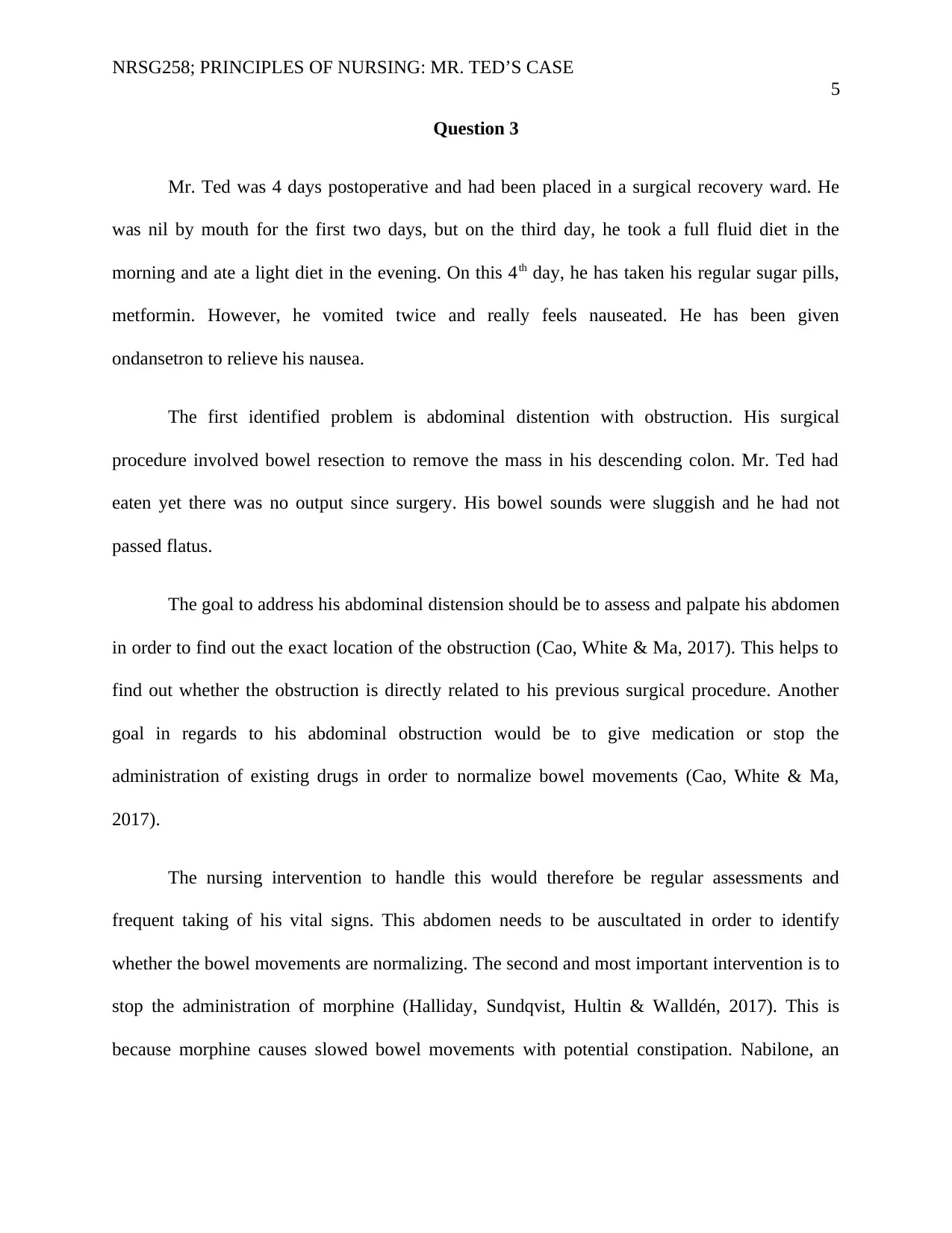
NRSG258; PRINCIPLES OF NURSING: MR. TED’S CASE
5
Question 3
Mr. Ted was 4 days postoperative and had been placed in a surgical recovery ward. He
was nil by mouth for the first two days, but on the third day, he took a full fluid diet in the
morning and ate a light diet in the evening. On this 4th day, he has taken his regular sugar pills,
metformin. However, he vomited twice and really feels nauseated. He has been given
ondansetron to relieve his nausea.
The first identified problem is abdominal distention with obstruction. His surgical
procedure involved bowel resection to remove the mass in his descending colon. Mr. Ted had
eaten yet there was no output since surgery. His bowel sounds were sluggish and he had not
passed flatus.
The goal to address his abdominal distension should be to assess and palpate his abdomen
in order to find out the exact location of the obstruction (Cao, White & Ma, 2017). This helps to
find out whether the obstruction is directly related to his previous surgical procedure. Another
goal in regards to his abdominal obstruction would be to give medication or stop the
administration of existing drugs in order to normalize bowel movements (Cao, White & Ma,
2017).
The nursing intervention to handle this would therefore be regular assessments and
frequent taking of his vital signs. This abdomen needs to be auscultated in order to identify
whether the bowel movements are normalizing. The second and most important intervention is to
stop the administration of morphine (Halliday, Sundqvist, Hultin & Walldén, 2017). This is
because morphine causes slowed bowel movements with potential constipation. Nabilone, an
5
Question 3
Mr. Ted was 4 days postoperative and had been placed in a surgical recovery ward. He
was nil by mouth for the first two days, but on the third day, he took a full fluid diet in the
morning and ate a light diet in the evening. On this 4th day, he has taken his regular sugar pills,
metformin. However, he vomited twice and really feels nauseated. He has been given
ondansetron to relieve his nausea.
The first identified problem is abdominal distention with obstruction. His surgical
procedure involved bowel resection to remove the mass in his descending colon. Mr. Ted had
eaten yet there was no output since surgery. His bowel sounds were sluggish and he had not
passed flatus.
The goal to address his abdominal distension should be to assess and palpate his abdomen
in order to find out the exact location of the obstruction (Cao, White & Ma, 2017). This helps to
find out whether the obstruction is directly related to his previous surgical procedure. Another
goal in regards to his abdominal obstruction would be to give medication or stop the
administration of existing drugs in order to normalize bowel movements (Cao, White & Ma,
2017).
The nursing intervention to handle this would therefore be regular assessments and
frequent taking of his vital signs. This abdomen needs to be auscultated in order to identify
whether the bowel movements are normalizing. The second and most important intervention is to
stop the administration of morphine (Halliday, Sundqvist, Hultin & Walldén, 2017). This is
because morphine causes slowed bowel movements with potential constipation. Nabilone, an
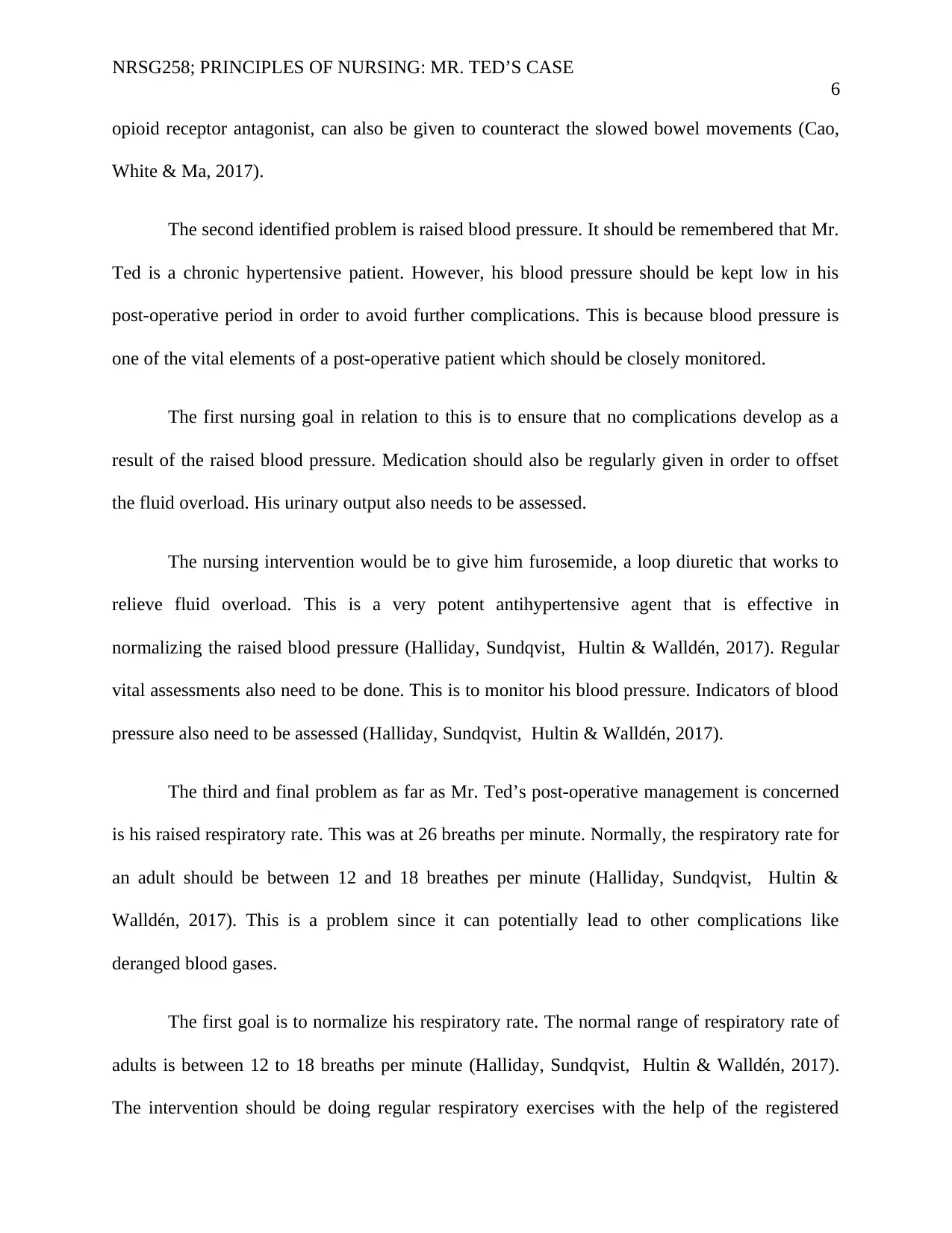
NRSG258; PRINCIPLES OF NURSING: MR. TED’S CASE
6
opioid receptor antagonist, can also be given to counteract the slowed bowel movements (Cao,
White & Ma, 2017).
The second identified problem is raised blood pressure. It should be remembered that Mr.
Ted is a chronic hypertensive patient. However, his blood pressure should be kept low in his
post-operative period in order to avoid further complications. This is because blood pressure is
one of the vital elements of a post-operative patient which should be closely monitored.
The first nursing goal in relation to this is to ensure that no complications develop as a
result of the raised blood pressure. Medication should also be regularly given in order to offset
the fluid overload. His urinary output also needs to be assessed.
The nursing intervention would be to give him furosemide, a loop diuretic that works to
relieve fluid overload. This is a very potent antihypertensive agent that is effective in
normalizing the raised blood pressure (Halliday, Sundqvist, Hultin & Walldén, 2017). Regular
vital assessments also need to be done. This is to monitor his blood pressure. Indicators of blood
pressure also need to be assessed (Halliday, Sundqvist, Hultin & Walldén, 2017).
The third and final problem as far as Mr. Ted’s post-operative management is concerned
is his raised respiratory rate. This was at 26 breaths per minute. Normally, the respiratory rate for
an adult should be between 12 and 18 breathes per minute (Halliday, Sundqvist, Hultin &
Walldén, 2017). This is a problem since it can potentially lead to other complications like
deranged blood gases.
The first goal is to normalize his respiratory rate. The normal range of respiratory rate of
adults is between 12 to 18 breaths per minute (Halliday, Sundqvist, Hultin & Walldén, 2017).
The intervention should be doing regular respiratory exercises with the help of the registered
6
opioid receptor antagonist, can also be given to counteract the slowed bowel movements (Cao,
White & Ma, 2017).
The second identified problem is raised blood pressure. It should be remembered that Mr.
Ted is a chronic hypertensive patient. However, his blood pressure should be kept low in his
post-operative period in order to avoid further complications. This is because blood pressure is
one of the vital elements of a post-operative patient which should be closely monitored.
The first nursing goal in relation to this is to ensure that no complications develop as a
result of the raised blood pressure. Medication should also be regularly given in order to offset
the fluid overload. His urinary output also needs to be assessed.
The nursing intervention would be to give him furosemide, a loop diuretic that works to
relieve fluid overload. This is a very potent antihypertensive agent that is effective in
normalizing the raised blood pressure (Halliday, Sundqvist, Hultin & Walldén, 2017). Regular
vital assessments also need to be done. This is to monitor his blood pressure. Indicators of blood
pressure also need to be assessed (Halliday, Sundqvist, Hultin & Walldén, 2017).
The third and final problem as far as Mr. Ted’s post-operative management is concerned
is his raised respiratory rate. This was at 26 breaths per minute. Normally, the respiratory rate for
an adult should be between 12 and 18 breathes per minute (Halliday, Sundqvist, Hultin &
Walldén, 2017). This is a problem since it can potentially lead to other complications like
deranged blood gases.
The first goal is to normalize his respiratory rate. The normal range of respiratory rate of
adults is between 12 to 18 breaths per minute (Halliday, Sundqvist, Hultin & Walldén, 2017).
The intervention should be doing regular respiratory exercises with the help of the registered
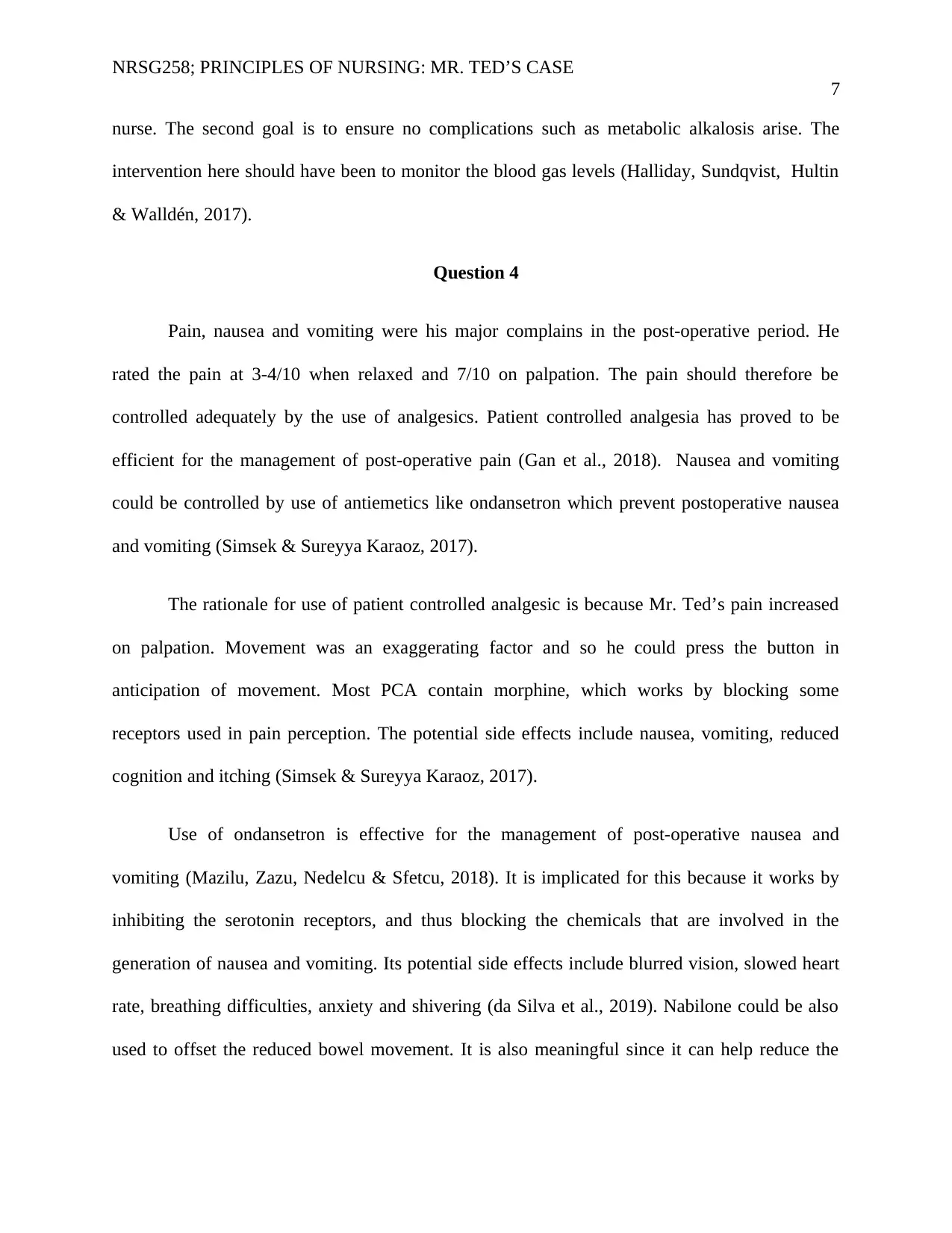
NRSG258; PRINCIPLES OF NURSING: MR. TED’S CASE
7
nurse. The second goal is to ensure no complications such as metabolic alkalosis arise. The
intervention here should have been to monitor the blood gas levels (Halliday, Sundqvist, Hultin
& Walldén, 2017).
Question 4
Pain, nausea and vomiting were his major complains in the post-operative period. He
rated the pain at 3-4/10 when relaxed and 7/10 on palpation. The pain should therefore be
controlled adequately by the use of analgesics. Patient controlled analgesia has proved to be
efficient for the management of post-operative pain (Gan et al., 2018). Nausea and vomiting
could be controlled by use of antiemetics like ondansetron which prevent postoperative nausea
and vomiting (Simsek & Sureyya Karaoz, 2017).
The rationale for use of patient controlled analgesic is because Mr. Ted’s pain increased
on palpation. Movement was an exaggerating factor and so he could press the button in
anticipation of movement. Most PCA contain morphine, which works by blocking some
receptors used in pain perception. The potential side effects include nausea, vomiting, reduced
cognition and itching (Simsek & Sureyya Karaoz, 2017).
Use of ondansetron is effective for the management of post-operative nausea and
vomiting (Mazilu, Zazu, Nedelcu & Sfetcu, 2018). It is implicated for this because it works by
inhibiting the serotonin receptors, and thus blocking the chemicals that are involved in the
generation of nausea and vomiting. Its potential side effects include blurred vision, slowed heart
rate, breathing difficulties, anxiety and shivering (da Silva et al., 2019). Nabilone could be also
used to offset the reduced bowel movement. It is also meaningful since it can help reduce the
7
nurse. The second goal is to ensure no complications such as metabolic alkalosis arise. The
intervention here should have been to monitor the blood gas levels (Halliday, Sundqvist, Hultin
& Walldén, 2017).
Question 4
Pain, nausea and vomiting were his major complains in the post-operative period. He
rated the pain at 3-4/10 when relaxed and 7/10 on palpation. The pain should therefore be
controlled adequately by the use of analgesics. Patient controlled analgesia has proved to be
efficient for the management of post-operative pain (Gan et al., 2018). Nausea and vomiting
could be controlled by use of antiemetics like ondansetron which prevent postoperative nausea
and vomiting (Simsek & Sureyya Karaoz, 2017).
The rationale for use of patient controlled analgesic is because Mr. Ted’s pain increased
on palpation. Movement was an exaggerating factor and so he could press the button in
anticipation of movement. Most PCA contain morphine, which works by blocking some
receptors used in pain perception. The potential side effects include nausea, vomiting, reduced
cognition and itching (Simsek & Sureyya Karaoz, 2017).
Use of ondansetron is effective for the management of post-operative nausea and
vomiting (Mazilu, Zazu, Nedelcu & Sfetcu, 2018). It is implicated for this because it works by
inhibiting the serotonin receptors, and thus blocking the chemicals that are involved in the
generation of nausea and vomiting. Its potential side effects include blurred vision, slowed heart
rate, breathing difficulties, anxiety and shivering (da Silva et al., 2019). Nabilone could be also
used to offset the reduced bowel movement. It is also meaningful since it can help reduce the
Paraphrase This Document
Need a fresh take? Get an instant paraphrase of this document with our AI Paraphraser

NRSG258; PRINCIPLES OF NURSING: MR. TED’S CASE
8
side effects of ondansetron such as breathing difficulties (Simsek & Sureyya Karaoz, 2017). This
is important since Mr. Ted had rough inspiratory course crackles.
8
side effects of ondansetron such as breathing difficulties (Simsek & Sureyya Karaoz, 2017). This
is important since Mr. Ted had rough inspiratory course crackles.
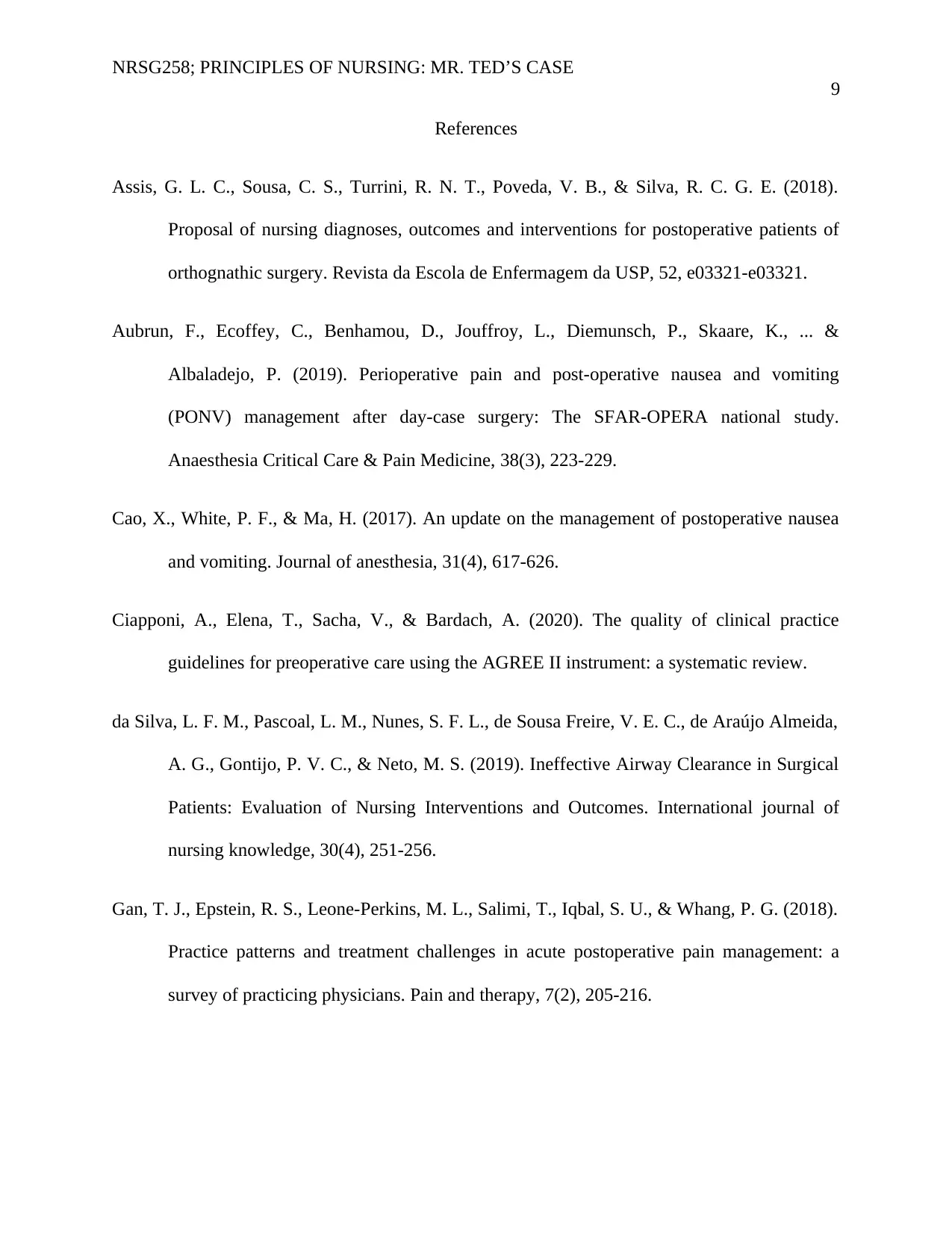
NRSG258; PRINCIPLES OF NURSING: MR. TED’S CASE
9
References
Assis, G. L. C., Sousa, C. S., Turrini, R. N. T., Poveda, V. B., & Silva, R. C. G. E. (2018).
Proposal of nursing diagnoses, outcomes and interventions for postoperative patients of
orthognathic surgery. Revista da Escola de Enfermagem da USP, 52, e03321-e03321.
Aubrun, F., Ecoffey, C., Benhamou, D., Jouffroy, L., Diemunsch, P., Skaare, K., ... &
Albaladejo, P. (2019). Perioperative pain and post-operative nausea and vomiting
(PONV) management after day-case surgery: The SFAR-OPERA national study.
Anaesthesia Critical Care & Pain Medicine, 38(3), 223-229.
Cao, X., White, P. F., & Ma, H. (2017). An update on the management of postoperative nausea
and vomiting. Journal of anesthesia, 31(4), 617-626.
Ciapponi, A., Elena, T., Sacha, V., & Bardach, A. (2020). The quality of clinical practice
guidelines for preoperative care using the AGREE II instrument: a systematic review.
da Silva, L. F. M., Pascoal, L. M., Nunes, S. F. L., de Sousa Freire, V. E. C., de Araújo Almeida,
A. G., Gontijo, P. V. C., & Neto, M. S. (2019). Ineffective Airway Clearance in Surgical
Patients: Evaluation of Nursing Interventions and Outcomes. International journal of
nursing knowledge, 30(4), 251-256.
Gan, T. J., Epstein, R. S., Leone-Perkins, M. L., Salimi, T., Iqbal, S. U., & Whang, P. G. (2018).
Practice patterns and treatment challenges in acute postoperative pain management: a
survey of practicing physicians. Pain and therapy, 7(2), 205-216.
9
References
Assis, G. L. C., Sousa, C. S., Turrini, R. N. T., Poveda, V. B., & Silva, R. C. G. E. (2018).
Proposal of nursing diagnoses, outcomes and interventions for postoperative patients of
orthognathic surgery. Revista da Escola de Enfermagem da USP, 52, e03321-e03321.
Aubrun, F., Ecoffey, C., Benhamou, D., Jouffroy, L., Diemunsch, P., Skaare, K., ... &
Albaladejo, P. (2019). Perioperative pain and post-operative nausea and vomiting
(PONV) management after day-case surgery: The SFAR-OPERA national study.
Anaesthesia Critical Care & Pain Medicine, 38(3), 223-229.
Cao, X., White, P. F., & Ma, H. (2017). An update on the management of postoperative nausea
and vomiting. Journal of anesthesia, 31(4), 617-626.
Ciapponi, A., Elena, T., Sacha, V., & Bardach, A. (2020). The quality of clinical practice
guidelines for preoperative care using the AGREE II instrument: a systematic review.
da Silva, L. F. M., Pascoal, L. M., Nunes, S. F. L., de Sousa Freire, V. E. C., de Araújo Almeida,
A. G., Gontijo, P. V. C., & Neto, M. S. (2019). Ineffective Airway Clearance in Surgical
Patients: Evaluation of Nursing Interventions and Outcomes. International journal of
nursing knowledge, 30(4), 251-256.
Gan, T. J., Epstein, R. S., Leone-Perkins, M. L., Salimi, T., Iqbal, S. U., & Whang, P. G. (2018).
Practice patterns and treatment challenges in acute postoperative pain management: a
survey of practicing physicians. Pain and therapy, 7(2), 205-216.
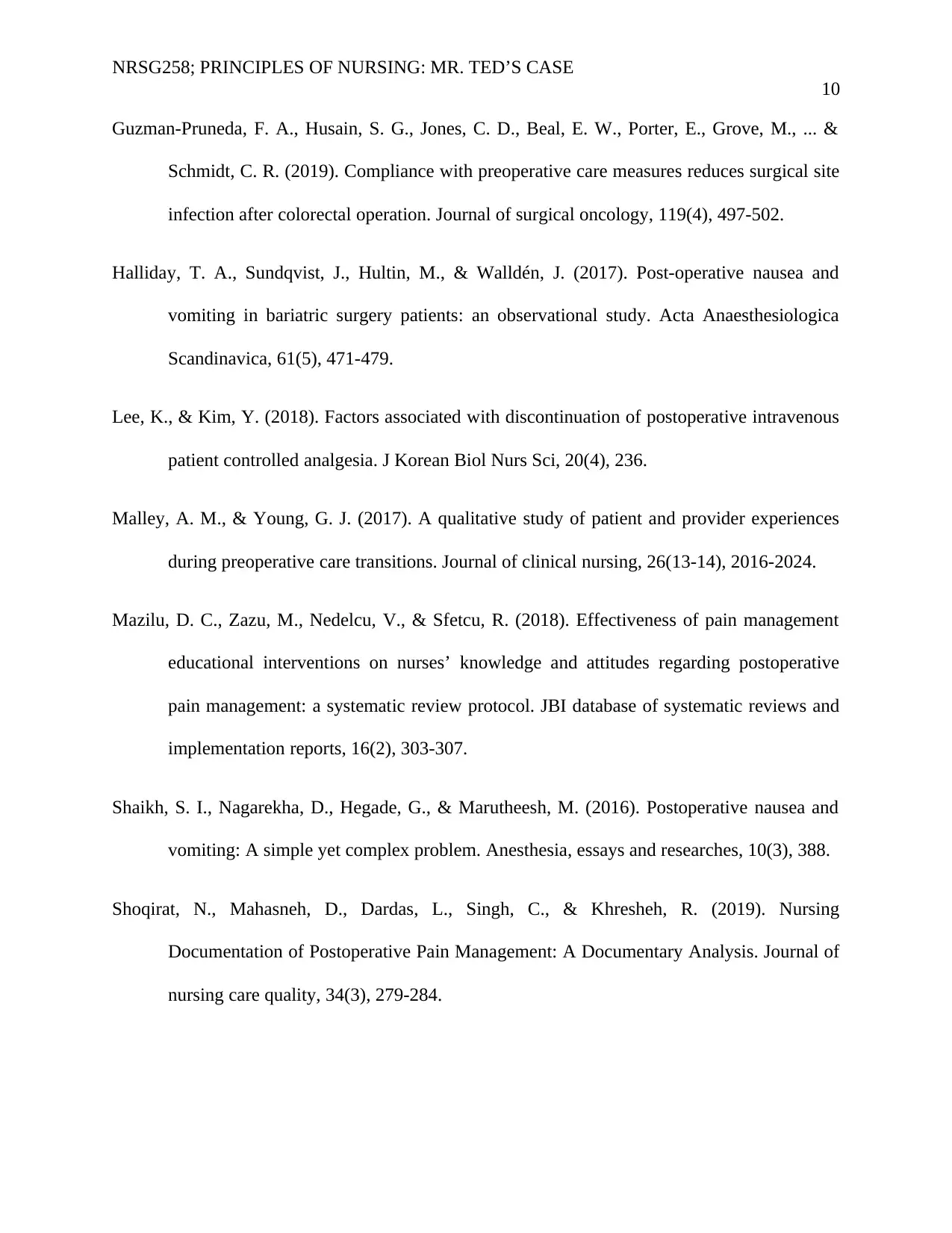
NRSG258; PRINCIPLES OF NURSING: MR. TED’S CASE
10
Guzman‐Pruneda, F. A., Husain, S. G., Jones, C. D., Beal, E. W., Porter, E., Grove, M., ... &
Schmidt, C. R. (2019). Compliance with preoperative care measures reduces surgical site
infection after colorectal operation. Journal of surgical oncology, 119(4), 497-502.
Halliday, T. A., Sundqvist, J., Hultin, M., & Walldén, J. (2017). Post‐operative nausea and
vomiting in bariatric surgery patients: an observational study. Acta Anaesthesiologica
Scandinavica, 61(5), 471-479.
Lee, K., & Kim, Y. (2018). Factors associated with discontinuation of postoperative intravenous
patient controlled analgesia. J Korean Biol Nurs Sci, 20(4), 236.
Malley, A. M., & Young, G. J. (2017). A qualitative study of patient and provider experiences
during preoperative care transitions. Journal of clinical nursing, 26(13-14), 2016-2024.
Mazilu, D. C., Zazu, M., Nedelcu, V., & Sfetcu, R. (2018). Effectiveness of pain management
educational interventions on nurses’ knowledge and attitudes regarding postoperative
pain management: a systematic review protocol. JBI database of systematic reviews and
implementation reports, 16(2), 303-307.
Shaikh, S. I., Nagarekha, D., Hegade, G., & Marutheesh, M. (2016). Postoperative nausea and
vomiting: A simple yet complex problem. Anesthesia, essays and researches, 10(3), 388.
Shoqirat, N., Mahasneh, D., Dardas, L., Singh, C., & Khresheh, R. (2019). Nursing
Documentation of Postoperative Pain Management: A Documentary Analysis. Journal of
nursing care quality, 34(3), 279-284.
10
Guzman‐Pruneda, F. A., Husain, S. G., Jones, C. D., Beal, E. W., Porter, E., Grove, M., ... &
Schmidt, C. R. (2019). Compliance with preoperative care measures reduces surgical site
infection after colorectal operation. Journal of surgical oncology, 119(4), 497-502.
Halliday, T. A., Sundqvist, J., Hultin, M., & Walldén, J. (2017). Post‐operative nausea and
vomiting in bariatric surgery patients: an observational study. Acta Anaesthesiologica
Scandinavica, 61(5), 471-479.
Lee, K., & Kim, Y. (2018). Factors associated with discontinuation of postoperative intravenous
patient controlled analgesia. J Korean Biol Nurs Sci, 20(4), 236.
Malley, A. M., & Young, G. J. (2017). A qualitative study of patient and provider experiences
during preoperative care transitions. Journal of clinical nursing, 26(13-14), 2016-2024.
Mazilu, D. C., Zazu, M., Nedelcu, V., & Sfetcu, R. (2018). Effectiveness of pain management
educational interventions on nurses’ knowledge and attitudes regarding postoperative
pain management: a systematic review protocol. JBI database of systematic reviews and
implementation reports, 16(2), 303-307.
Shaikh, S. I., Nagarekha, D., Hegade, G., & Marutheesh, M. (2016). Postoperative nausea and
vomiting: A simple yet complex problem. Anesthesia, essays and researches, 10(3), 388.
Shoqirat, N., Mahasneh, D., Dardas, L., Singh, C., & Khresheh, R. (2019). Nursing
Documentation of Postoperative Pain Management: A Documentary Analysis. Journal of
nursing care quality, 34(3), 279-284.
Secure Best Marks with AI Grader
Need help grading? Try our AI Grader for instant feedback on your assignments.
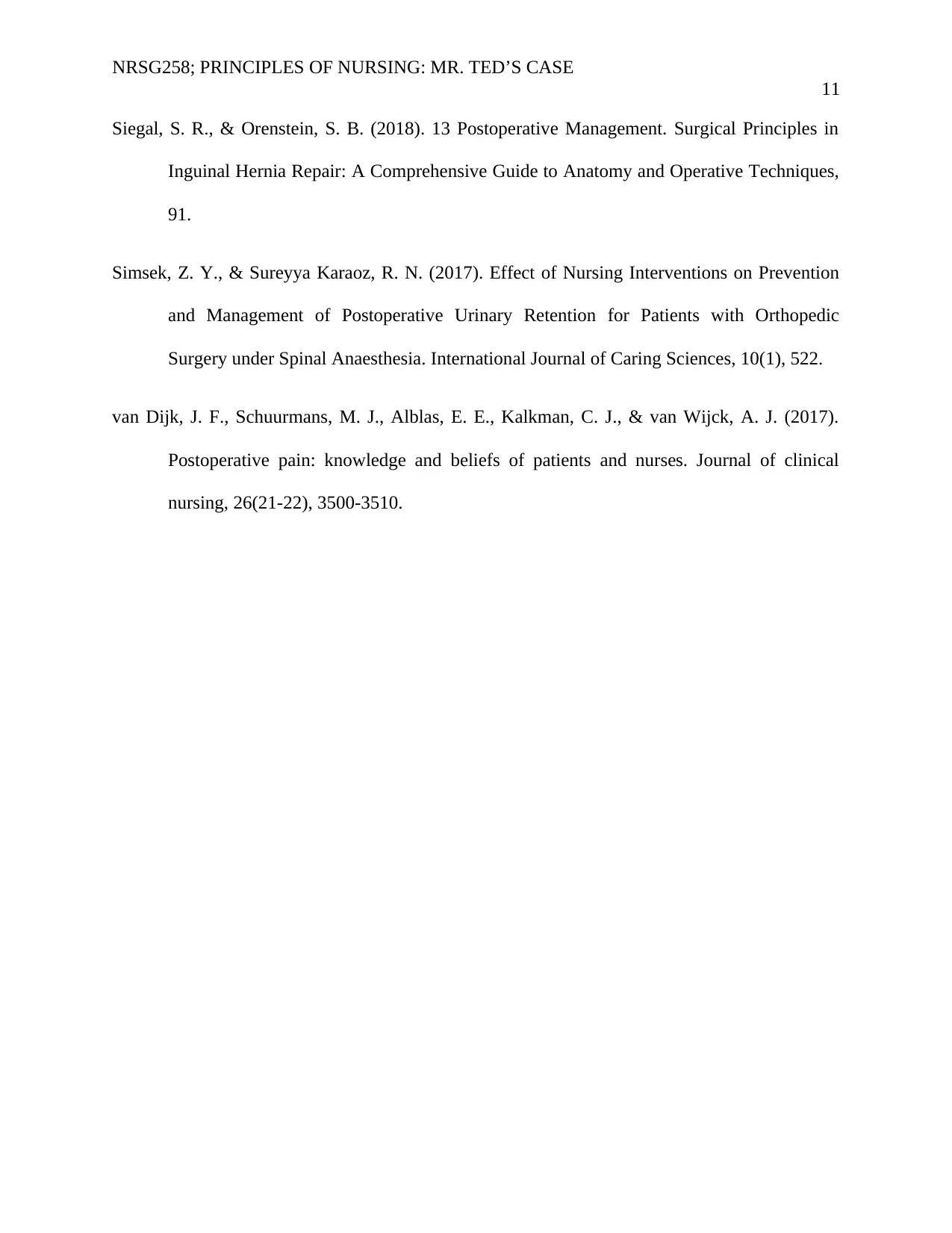
NRSG258; PRINCIPLES OF NURSING: MR. TED’S CASE
11
Siegal, S. R., & Orenstein, S. B. (2018). 13 Postoperative Management. Surgical Principles in
Inguinal Hernia Repair: A Comprehensive Guide to Anatomy and Operative Techniques,
91.
Simsek, Z. Y., & Sureyya Karaoz, R. N. (2017). Effect of Nursing Interventions on Prevention
and Management of Postoperative Urinary Retention for Patients with Orthopedic
Surgery under Spinal Anaesthesia. International Journal of Caring Sciences, 10(1), 522.
van Dijk, J. F., Schuurmans, M. J., Alblas, E. E., Kalkman, C. J., & van Wijck, A. J. (2017).
Postoperative pain: knowledge and beliefs of patients and nurses. Journal of clinical
nursing, 26(21-22), 3500-3510.
11
Siegal, S. R., & Orenstein, S. B. (2018). 13 Postoperative Management. Surgical Principles in
Inguinal Hernia Repair: A Comprehensive Guide to Anatomy and Operative Techniques,
91.
Simsek, Z. Y., & Sureyya Karaoz, R. N. (2017). Effect of Nursing Interventions on Prevention
and Management of Postoperative Urinary Retention for Patients with Orthopedic
Surgery under Spinal Anaesthesia. International Journal of Caring Sciences, 10(1), 522.
van Dijk, J. F., Schuurmans, M. J., Alblas, E. E., Kalkman, C. J., & van Wijck, A. J. (2017).
Postoperative pain: knowledge and beliefs of patients and nurses. Journal of clinical
nursing, 26(21-22), 3500-3510.
1 out of 11
Related Documents
Your All-in-One AI-Powered Toolkit for Academic Success.
+13062052269
info@desklib.com
Available 24*7 on WhatsApp / Email
![[object Object]](/_next/static/media/star-bottom.7253800d.svg)
Unlock your academic potential
© 2024 | Zucol Services PVT LTD | All rights reserved.





